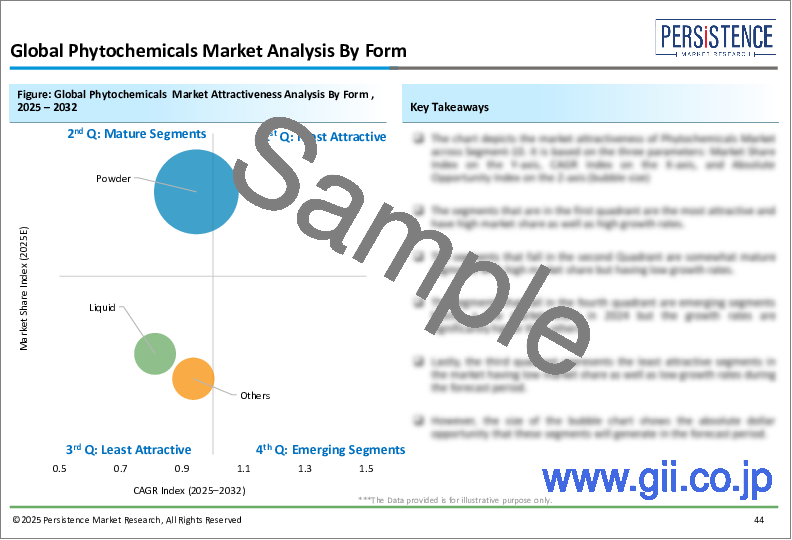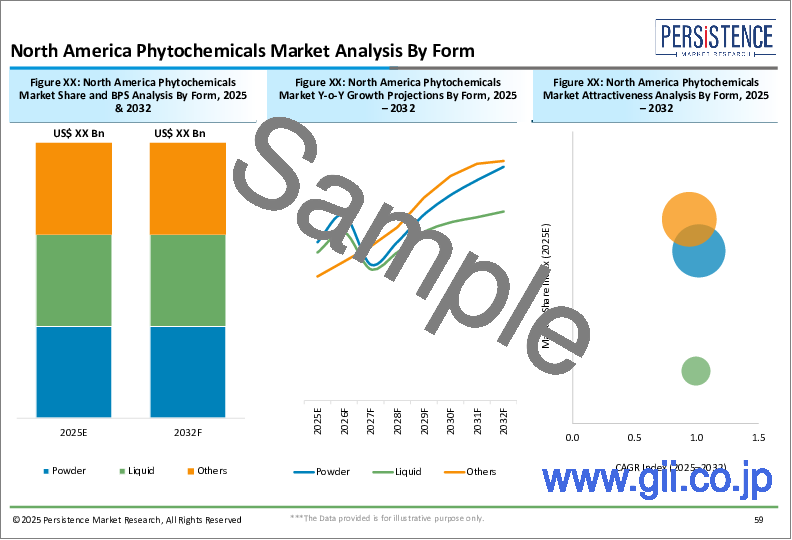|
|
市場調査レポート
商品コード
1689634
ファイトケミカル市場:世界の産業分析、市場規模・シェア・成長・動向、将来予測 (2025~2032年)Phytochemicals Market: Global Industry Analysis, Size, Share, Growth, Trends, and Forecast, 2025 - 2032 |
||||||
カスタマイズ可能
|
|||||||
| ファイトケミカル市場:世界の産業分析、市場規模・シェア・成長・動向、将来予測 (2025~2032年) |
|
出版日: 2025年03月21日
発行: Persistence Market Research
ページ情報: 英文 275 Pages
納期: 2~5営業日
|
全表示
- 概要
- 目次
Persistence Market Research社はこのほど、世界のファイトケミカル市場に関する包括的な調査レポートを発表し、原動力、新たな動向、機会、課題など、主要な市場力学の詳細な分析を提供しました。本レポートは市場情勢を詳細に理解し、利害関係者が十分な情報を得た上で意思決定できるよう支援します。
主要な洞察
- ファイトケミカルの市場規模 (2025年):82億630万米ドル
- 市場規模の予測 (金額ベース、2032年):150億140万米ドル
- 世界市場の成長率 (CAGR、2025~2032年):9.0%
ファイトケミカル市場:分析範囲
ファイトケミカルは、植物に含まれる天然由来の生物活性化合物であり、様々な健康効果をもたらします。これらの化合物は、食品・飲料、医薬品、栄養補助食品、化粧品、パーソナルケアなど、さまざまな産業で広く使用されています。植物由来の成分に対する需要の高まり、天然健康サプリメントに対する消費者の嗜好の高まり、ファイトケミカルの抗酸化作用や抗炎症作用に対する意識の高まりは、市場成長を促進する主な要因です。また、機能性食品と栄養補助食品における研究の進展も市場に影響を与えています。
市場成長の促進要因:
世界のファイトケミカル市場は、主に天然で植物由来の製品に対する消費者の需要の増加が牽引しています。栄養補助食品や機能性食品産業の拡大、予防ヘルスケアに対する意識の高まり、化粧品やパーソナルケア製品におけるオーガニック成分への傾倒の高まりなどが、市場の成長を後押ししています。さらに、抽出・精製プロセスの技術進歩により、ファイトケミカルの生産効率と費用対効果が改善され、市場拡大をさらに後押ししています。
市場の抑制要因:
強い成長が見込まれるもの、ファイトケミカル市場は、高い抽出コストや天然の生物活性化合物に関連する複雑な規制の枠組みといった課題に直面しています。また、合成代替品が低価格で入手可能であることも、市場浸透に影響を与えています。さらに、季節的・気候的要因による原料供給の変動は価格変動につながり、メーカーやエンドユーザーに影響を与えます。
市場機会:
ファイトケミカル市場は、特に拡大する栄養補助食品と機能性食品分野で大きな成長機会をもたらしています。革新的な植物ベースの製剤や持続可能な抽出方法の研究開発への投資が増加し、市場成長の新たな道が開けると期待されます。さらに、クリーンラベル製品やオーガニック製品に対する需要の高まりは、化粧品、医薬品、動物飼料産業における新規のファイトケミカルの応用を模索するメーカーを後押ししています。食品、製薬、化粧品企業との戦略的提携やパートナーシップは、市場参入をさらに強化すると思われます。
当レポートで回答する主な質問
- ファイトケミカル市場の世界的成長を促進する主な要因は何か?
- ファイトケミカルを最も多く採用している地域と市場セグメントは?
- 抽出技術の進歩は競合情勢にどのような影響を与えているか?
- ファイトケミカル市場の主要企業はどれか?競争力を維持するためにどのような戦略を実施しているのか?
- 世界のファイトケミカル市場の新たな動向と将来性は?
目次
第1章 エグゼクティブサマリー
第2章 市場概要
- 市場範囲/ 分類
- 市場の定義/ 範囲/ 制限
第3章 主要な市場動向
- 世界の食品・飲料業界の動向
- 市場に影響を与える主な動向
- 主な投資動向
第4章 重要成功要因
- 製品の採用/使用状況分析
- 製品のUSP/特徴
- 戦略的プロモーション戦略
第5章 世界のファイトケミカル市場の需要分析(2019~2032年)
- 過去の市場規模の分析 (数量 (トン)・金額ベース (10億米ドル)、2019~2024年)
- 現在の市場規模の分析と予測 (数量 (トン)・金額ベース (10億米ドル)、2025~2032年)
- 絶対的収益機会分析
- 増分収益機会
第6章 世界のファイトケミカル市場:価格分析
- 種類別・地域別価格分析
- 世界平均価格分析ベンチマーク
第7章 市場背景
- マクロ経済要因
- 世界の食品・飲料業界の展望
- 世界の化粧品・パーソナルケア業界の展望
- 世界の製薬業界の展望
- 世界の栄養補助食品産業の概要
- 世界の動物飼料産業の概要
- バリューチェーン
- 市場力学
- 予測要因:関連性と影響
第8章 世界のファイトケミカル市場の分析:種類別(2019~2032年)
- イントロダクション
- 過去の市場規模の分析:種類別 (数量 (トン)・金額ベース (10億米ドル)、2019~2024年)
- 現在の市場規模の分析と予測:種類別 (数量 (トン)・金額ベース (10億米ドル)、2025~2032年)
- カロテノイド
- フラボノイド
- 植物ステロール
- ポリフェノール
- その他
- 市場魅力分析:種類別
第9章 世界のファイトケミカル市場の分析:用途別(2019~2032年)
- イントロダクション
- 過去の市場規模の分析:用途別 (数量 (トン)・金額ベース (10億米ドル)、2019~2024年)
- 現在の市場規模の分析と予測:用途別 (数量 (トン)・金額ベース (10億米ドル)、2025~2032年)
- 食品・飲料業界
- 化粧品・パーソナルケア製品
- 医薬品
- 栄養補助食品
- 動物飼料
- その他
- 市場魅力分析:用途別
第10章 世界のファイトケミカル市場の分析:地域別(2019~2032年)
- イントロダクション
- 過去の市場規模の分析:地域別 (数量 (トン)・金額ベース (10億米ドル)、2019~2024年)
- 現在の市場規模の分析と予測:地域別 (数量 (トン)・金額ベース (10億米ドル)、2025~2032年)
- 北米
- ラテンアメリカ
- 欧州
- 東アジア
- 南アジア・太平洋
- 中東・アフリカ
- 市場魅力分析:地域別
第11章 北米のファイトケミカル市場の分析(2019~2032年)
第12章 ラテンアメリカのファイトケミカル市場の分析(2019~2032年)
第13章 欧州のファイトケミカル市場の分析(2019~2032年)
第14章 東アジアのファイトケミカル市場の分析(2019~2032年)
第15章 南アジアおよび太平洋地域のファイトケミカル市場の分析(2019~2032年)
第16章 中東およびアフリカのファイトケミカル市場の分析(2019~2032年)
第17章 ファイトケミカル市場の分析:国別(2025年)
- イントロダクション
- 米国
- カナダ
- 東アジア
- ブラジル
- アルゼンチン
- ドイツ
- イタリア
- フランス
- 英国
- スペイン
- ポーランド
- ロシア
- 中国
- 日本
- 韓国
- インド
- オセアニア(オーストラリア、ニュージーランド)
- トルコ
- 南アフリカ
第18章 市場構造の分析
- 企業階層別市場分析(エンドウ豆タンパク質)
- 主要企業の市場シェア分析
- 市場プレゼンス分析
第19章 競合分析
- 競合ダッシュボード
- 競合ベンチマーク
- 競合の詳細
- BASF SE
- DSM. NV
- Chr. Hansen Holding A/S
- Dohler GmbH
- Kothari Phytochemicals &Industries Ltd.
- Indena SPA
- Phyto Life Sciences Pvt. Ltd
- Naturex SA
- Sabinsa Corporation
- K. Patel Phyto Extractions Pvt. Ltd
- Herbochem
第20章 使用される仮定と頭字語
第21章 調査手法
Persistence Market Research has recently released a comprehensive report on the global Phytochemicals Market, providing an in-depth analysis of key market dynamics, including driving forces, emerging trends, opportunities, and challenges. This report offers a detailed understanding of the market landscape, helping stakeholders make well-informed decisions.
Key Insights:
- Phytochemicals Market Size (2025E): US$ 8,206.30 Mn
- Projected Market Value (2032F): US$ 15,001.40 Mn
- Global Market Growth Rate (CAGR 2025 to 2032): 9.0%
Phytochemicals Market - Report Scope:
Phytochemicals are naturally occurring bioactive compounds found in plants that offer various health benefits. These compounds are widely used across multiple industries, including food and beverage, pharmaceuticals, nutraceuticals, cosmetics, and personal care. The rising demand for plant-based ingredients, increasing consumer preference for natural health supplements, and growing awareness of phytochemicals' antioxidant and anti-inflammatory properties are key factors driving market growth. The market is also influenced by research advancements in functional foods and dietary supplements.
Market Growth Drivers:
The global Phytochemicals Market is primarily driven by increasing consumer demand for natural and plant-based products. The expanding nutraceutical and functional food industry, growing awareness of preventive healthcare, and rising inclination towards organic ingredients in cosmetics and personal care products are fueling market growth. Additionally, technological advancements in extraction and purification processes have improved the efficiency and cost-effectiveness of phytochemical production, further supporting market expansion.
Market Restraints:
Despite strong growth prospects, the Phytochemicals Market faces challenges such as high extraction costs and complex regulatory frameworks associated with natural bioactive compounds. The availability of synthetic alternatives at lower prices also impacts market penetration. Moreover, variations in raw material supply due to seasonal and climatic factors can lead to price fluctuations, affecting manufacturers and end-users.
Market Opportunities:
The Phytochemicals Market presents significant growth opportunities, particularly in the expanding nutraceuticals and functional food segments. Increased investment in research and development for innovative plant-based formulations and sustainable extraction methods is expected to create new avenues for market growth. Additionally, the rising demand for clean-label and organic products is encouraging manufacturers to explore novel phytochemical applications in cosmetics, pharmaceuticals, and animal feed industries. Strategic collaborations and partnerships with food, pharmaceutical, and cosmetic companies will further enhance market reach.
Key Questions Answered in the Report:
- What are the primary factors driving the global growth of the Phytochemicals Market?
- Which regions and market segments are witnessing the highest adoption of phytochemicals?
- How are advancements in extraction technologies impacting the competitive landscape?
- Who are the key players in the Phytochemicals Market, and what strategies are they implementing to remain competitive?
- What are the emerging trends and future prospects in the global Phytochemicals Market?
Competitive Intelligence and Business Strategy:
Leading companies in the global Phytochemicals Market, such as BASF SE, Chr. Hansen Holding A/S, and DSM N.V., are investing in research, innovation, and product diversification to strengthen their market positions. These companies are focusing on sustainable extraction techniques, expanding their product portfolios, and forming strategic partnerships with food, pharmaceutical, and cosmetic industries. Increasing investment in plant-based nutraceuticals and clean-label solutions is expected to drive competition, with key players differentiating themselves through quality, efficacy, and eco-friendly sourcing practices.
Key Companies Profiled:
- BASF SE
- Chr. Hansen Holding A/S
- DSM N.V.
- Dohler GmbH
- Kothari Phytochemicals & Industries Ltd.
- Indena SPA
- Phyto Life Sciences Pvt. Ltd.
- Sabinsa Corporation
- HimPharma
- Kisalaya Herbals Ltd.
Phytochemicals Industry Research by Category:
By Type:
- Carotenoids
- Flavonoids
- Phytosterols
- Polyphenols
- Others
By Application:
- Food and Beverage Industry
- Cosmetics and Personal Care Products
- Pharmaceuticals
- Nutraceuticals
- Animal Feed
- Others
By Region:
- North America
- Latin America
- Europe
- South Asia & Pacific
- East Asia
- Middle East & Africa
Table of Contents
1. Executive Summary
- 1.1. Global Market Outlook
- 1.2. Demand Side Trends
- 1.3. Supply Side Trends
- 1.4. Analysis and Recommendations
2. Market Overview
- 2.1. Market Coverage / Taxonomy
- 2.2. Market Definition / Scope / Limitations
3. Key Market Trends
- 3.1. Global Food & Beverage Industry Trend
- 3.2. Key Trends Impacting the Market
- 3.3. Key Investments Trends
4. Key Success Factors
- 4.1. Product Adoption / Usage Analysis
- 4.2. Product USPs / Features
- 4.3. Strategic Promotional Strategies
5. Global Phytochemicals Market Demand Analysis 2019-2032
- 5.1. Historical Market Value (US$ Mn) and Volume (in Tons) Analysis, 2019-2024
- 5.2. Current and Future Market Value (US$ Mn) and Volume (in Tons) Projections, 2025-2032
- 5.2.1. Absolute $ Opportunity Analysis
- 5.2.2. Incremental $ Opportunity
6. Global Phytochemicals Market - Pricing Analysis
- 6.1. Regional Pricing Analysis By Type
- 6.2. Global Average Pricing Analysis Benchmark
7. Market Background
- 7.1. Macro-Economic Factors
- 7.1.1. Global GDP Growth Outlook
- 7.1.2. Global Urbanization Outlook
- 7.1.3. Final Consumption Expenditure
- 7.1.4. Global Food Security Index
- 7.2. Global Food & Beverage Industry Outlook
- 7.3. Global Cosmetics & Personal Care Industry Outlook
- 7.4. Global Pharmaceutical Industry Outlook
- 7.5. Global Nutraceutical Industry Overview
- 7.6. Global Animal Feed Industry Overview
- 7.7. Value Chain
- 7.8. Market Dynamics
- 7.8.1. Drivers
- 7.8.2. Restraints
- 7.8.3. Opportunity Analysis
- 7.9. Forecast Factors - Relevance & Impact
8. Global Phytochemicals Market Analysis 2019-2032, by Type
- 8.1. Introduction
- 8.2. Historical Market Size (US$ Mn) and Volume (in Tons) Analysis By Type, 2019-2024
- 8.3. Current and Future Market Size (US$ Mn) and Volume (in Tons) Analysis and Forecast By Type, 2025-2032
- 8.3.1. Carotenoids
- 8.3.2. Flavonoids
- 8.3.3. Phytosterols
- 8.3.4. Polyphenols
- 8.3.5. Others
- 8.4. Market Attractiveness Analysis By Type
9. Global Phytochemicals Market Analysis 2019-2032, By Application
- 9.1. Introduction
- 9.2. Historical Market Size (US$ Mn) and Volume (in Tons) Analysis By Application, 2019-2024
- 9.3. Current and Future Market Size (US$ Mn) and Volume (in Tons) Analysis and Forecast By Application, 2025-2032
- 9.3.1. Food & beverage Industry
- 9.3.2. Cosmetics & Personal Care Products
- 9.3.3. Pharmaceuticals
- 9.3.4. Nutraceuticals
- 9.3.5. Animal Feed
- 9.3.6. Others
- 9.4. Market Attractiveness Analysis By Application
10. Global Phytochemicals Market Analysis 2019-2032, by Region
- 10.1. Introduction
- 10.2. Historical Market Size (US$ Mn) and Volume (in Tons) Analysis By Region, 2019-2024
- 10.3. Current Market Size (US$ Mn) and Volume (in Tons) Analysis and Forecast By Region, 2025-2032
- 10.3.1. North America
- 10.3.2. Latin America
- 10.3.3. Europe
- 10.3.4. East Asia
- 10.3.5. South Asia & Pacific
- 10.3.6. Middle East & Africa
- 10.4. Market Attractiveness Analysis By Region
11. North America Phytochemicals Market Analysis 2019-2032
- 11.1. Introduction
- 11.2. Historical Market Size (US$ Mn) and Volume (in Tons) Trend Analysis By Market Taxonomy, 2019-2024
- 11.3. Market Size (US$ Mn) and Volume (in Tons) Forecast By Market Taxonomy, 2025-2032
- 11.3.1. By Country
- 11.3.1.1. U.S.
- 11.3.1.2. Canada
- 11.3.2. By Type
- 11.3.3. By Application
- 11.3.1. By Country
- 11.4. Market Attractiveness Analysis
- 11.4.1. By Country
- 11.4.2. By Type
- 11.4.3. By Application
- 11.5. Drivers and Restraints - Impact Analysis
12. Latin America Phytochemicals Market Analysis 2019-2032
- 12.1. Introduction
- 12.2. Historical Market Size (US$ Mn) and Volume (in Tons) Trend Analysis By Market Taxonomy, 2019-2024
- 12.3. Market Size (US$ Mn) and Volume (in Tons) Forecast By Market Taxonomy, 2025-2032
- 12.3.1. By Country
- 12.3.1.1. Brazil
- 12.3.1.2. Mexico
- 12.3.1.3. Rest of Latin America
- 12.3.2. By Type
- 12.3.3. By Application
- 12.3.1. By Country
- 12.4. Market Attractiveness Analysis
- 12.4.1. By Country
- 12.4.2. By Type
- 12.4.3. By Application
- 12.5. Drivers and Restraints - Impact Analysis
13. Europe Phytochemicals Market Analysis 2019-2032
- 13.1. Introduction
- 13.2. Historical Market Size (US$ Mn) and Volume (in Tons) Trend Analysis By Market Taxonomy, 2019-2024
- 13.3. Market Size (US$ Mn) and Volume (in Tons) Forecast By Market Taxonomy, 2025-2032
- 13.3.1. By Country
- 13.3.1.1. France
- 13.3.1.2. Germany
- 13.3.1.3. Spain
- 13.3.1.4. U.K.
- 13.3.1.5. Italy
- 13.3.1.6. BENELUX
- 13.3.1.7. Nordic
- 13.3.1.8. Russia
- 13.3.1.9. Poland
- 13.3.1.10. Rest of Europe
- 13.3.2. By Type
- 13.3.3. By Application
- 13.3.1. By Country
- 13.4. Market Attractiveness Analysis
- 13.4.1. By Country
- 13.4.2. By Type
- 13.4.3. By Application
- 13.5. Drivers and Restraints - Impact Analysis
14. East Asia Phytochemicals Market Analysis 2019-2032
- 14.1. Introduction
- 14.2. Historical Market Size (US$ Mn) and Volume (in Tons) Trend Analysis By Market Taxonomy, 2019-2024
- 14.3. Market Size (US$ Mn) and Volume (in Tons) Forecast By Market Taxonomy, 2025-2032
- 14.3.1. By Country
- 14.3.1.1. China
- 14.3.1.2. Japan
- 14.3.1.3. South Korea
- 14.3.2. By Type
- 14.3.3. By Application
- 14.3.1. By Country
- 14.4. Market Attractiveness Analysis
- 14.4.1. By Country
- 14.4.2. By Type
- 14.4.3. By Application
- 14.5. Drivers and Restraints - Impact Analysis
15. South Asia and Pacific Phytochemicals Market Analysis 2019-2032
- 15.1. Introduction
- 15.2. Historical Market Size (US$ Mn) and Volume (in Tons) Trend Analysis By Market Taxonomy, 2019-2024
- 15.3. Market Size (US$ Mn) and Volume (in Tons) Forecast By Market Taxonomy, 2025-2032
- 15.3.1. By Country
- 15.3.1.1. India
- 15.3.1.2. ASEAN
- 15.3.1.3. Oceania (Australia & New Zealand)
- 15.3.1.4. Rest of South Asia & Pacific
- 15.3.2. By Type
- 15.3.3. By Application
- 15.3.1. By Country
- 15.4. Market Attractiveness Analysis
- 15.4.1. By Country
- 15.4.2. By Type
- 15.4.3. By Application
- 15.5. Drivers and Restraints - Impact Analysis
16. Middle East and Africa Phytochemicals Market Analysis 2019-2032
- 16.1. Introduction
- 16.2. Historical Market Size (US$ Mn) and Volume (in Tons) Trend Analysis By Market Taxonomy, 2019-2024
- 16.3. Market Size (US$ Mn) and Volume (in Tons) Forecast By Market Taxonomy, 2025-2032
- 16.3.1. By Country
- 16.3.1.1. GCC Countries
- 16.3.1.2. South Africa
- 16.3.1.3. Rest of Middle East and Africa
- 16.3.2. By Type
- 16.3.3. By Application
- 16.3.1. By Country
- 16.4. Market Attractiveness Analysis
- 16.4.1. By Country
- 16.4.2. By Type
- 16.4.3. By Application
- 16.5. Drivers and Restraints - Impact Analysis
17. Country Wise Phytochemicals Market Analysis, 2025
- 17.1. Introduction
- 17.1.1. Market Value Proportion Analysis, By Key Countries
- 17.1.2. Global Vs. Country Growth Comparison
- 17.2. U.S. Phytochemicals Market Analysis
- 17.2.1. By Type
- 17.2.2. By Application
- 17.3. Canada Phytochemicals Market Analysis
- 17.3.1. By Type
- 17.3.2. By Application
- 17.4. East Asia Phytochemicals Market Analysis
- 17.4.1. By Type
- 17.4.2. By Application
- 17.5. Brazil Phytochemicals Market Analysis
- 17.5.1. By Type
- 17.5.2. By Application
- 17.6. Argentina Phytochemicals Market Analysis
- 17.6.1. By Type
- 17.6.2. By Application
- 17.7. Germany Phytochemicals Market Analysis
- 17.7.1. By Type
- 17.7.2. By Application
- 17.8. Italy Phytochemicals Market Analysis
- 17.8.1. By Type
- 17.8.2. By Application
- 17.9. France Phytochemicals Market Analysis
- 17.9.1. By Type
- 17.9.2. By Application
- 17.10. U.K. Phytochemicals Market Analysis
- 17.10.1. By Type
- 17.10.2. By Application
- 17.11. Spain Phytochemicals Market Analysis
- 17.11.1. By Type
- 17.11.2. By Application
- 17.12. Poland Phytochemicals Market Analysis
- 17.12.1. By Type
- 17.12.2. By Application
- 17.13. Russia Phytochemicals Market Analysis
- 17.13.1. By Type
- 17.13.2. By Application
- 17.14. China Phytochemicals Market Analysis
- 17.14.1. By Type
- 17.14.2. By Application
- 17.15. Japan Phytochemicals Market Analysis
- 17.15.1. By Type
- 17.15.2. By Application
- 17.16. S. Korea Phytochemicals Market Analysis
- 17.16.1. By Type
- 17.16.2. By Application
- 17.17. India Phytochemicals Market Analysis
- 17.17.1. By Type
- 17.17.2. By Application
- 17.18. Oceania (Australia and New Zealand) Phytochemicals Market Analysis
- 17.18.1. By Type
- 17.18.2. By Application
- 17.19. Turkey Phytochemicals Market Analysis
- 17.19.1. By Type
- 17.19.2. By Application
- 17.20. South Africa Phytochemicals Market Analysis
- 17.20.1. By Type
- 17.20.2. By Application
18. Market Structure Analysis
- 18.1. Market Analysis by Tier of Companies (Pea Protein)
- 18.2. Market Share Analysis of Top Players
- 18.3. Market Presence Analysis
19. Competition Analysis
- 19.1. Competition Dashboard
- 19.2. Competition Benchmarking
- 19.3. Competition Deep Dive
- 19.3.1. BASF SE
- 19.3.1.1. Overview
- 19.3.1.2. Product Portfolio
- 19.3.1.3. Profitability by Market Segments (Product/Channel/Region)
- 19.3.1.4. Sales Footprint
- 19.3.1.5. Strategy Overview
- 19.3.2. DSM. N.V.
- 19.3.2.1. Overview
- 19.3.2.2. Product Portfolio
- 19.3.2.3. Profitability by Market Segments (Product/Channel/Region)
- 19.3.2.4. Sales Footprint
- 19.3.2.5. Strategy Overview
- 19.3.3. Chr. Hansen Holding A/S
- 19.3.3.1. Overview
- 19.3.3.2. Product Portfolio
- 19.3.3.3. Profitability by Market Segments (Product/Channel/Region)
- 19.3.3.4. Sales Footprint
- 19.3.3.5. Strategy Overview
- 19.3.4. Dohler GmbH
- 19.3.4.1. Overview
- 19.3.4.2. Product Portfolio
- 19.3.4.3. Profitability by Market Segments (Product/Channel/Region)
- 19.3.4.4. Sales Footprint
- 19.3.4.5. Strategy Overview
- 19.3.5. Kothari Phytochemicals & Industries Ltd.
- 19.3.5.1. Overview
- 19.3.5.2. Product Portfolio
- 19.3.5.3. Profitability by Market Segments (Product/Channel/Region)
- 19.3.5.4. Sales Footprint
- 19.3.5.5. Strategy Overview
- 19.3.6. Indena SPA
- 19.3.6.1. Overview
- 19.3.6.2. Product Portfolio
- 19.3.6.3. Profitability by Market Segments (Product/Channel/Region)
- 19.3.6.4. Sales Footprint
- 19.3.6.5. Strategy Overview
- 19.3.7. Phyto Life Sciences Pvt. Ltd
- 19.3.7.1. Overview
- 19.3.7.2. Product Portfolio
- 19.3.7.3. Profitability by Market Segments (Product/Channel/Region)
- 19.3.7.4. Sales Footprint
- 19.3.7.5. Strategy Overview
- 19.3.8. Naturex SA
- 19.3.8.1. Overview
- 19.3.8.2. Product Portfolio
- 19.3.8.3. Profitability by Market Segments (Product/Channel/Region)
- 19.3.8.4. Sales Footprint
- 19.3.8.5. Strategy Overview
- 19.3.9. Sabinsa Corporation
- 19.3.9.1. Overview
- 19.3.9.2. Product Portfolio
- 19.3.9.3. Profitability by Market Segments (Product/Channel/Region)
- 19.3.9.4. Sales Footprint
- 19.3.9.5. Strategy Overview
- 19.3.10. K. Patel Phyto Extractions Pvt. Ltd
- 19.3.10.1. Overview
- 19.3.10.2. Product Portfolio
- 19.3.10.3. Profitability by Market Segments (Product/Channel/Region)
- 19.3.10.4. Sales Footprint
- 19.3.10.5. Strategy Overview
- 19.3.11. Herbochem
- 19.3.11.1. Overview
- 19.3.11.2. Product Portfolio
- 19.3.11.3. Profitability by Market Segments (Product/Channel/Region)
- 19.3.11.4. Sales Footprint
- 19.3.11.5. Strategy Overview
- 19.3.1. BASF SE





